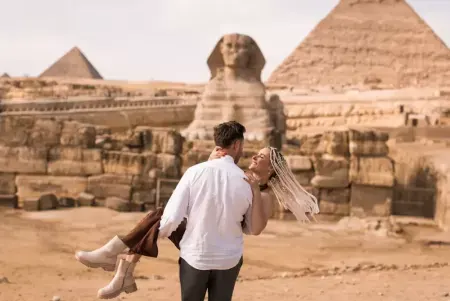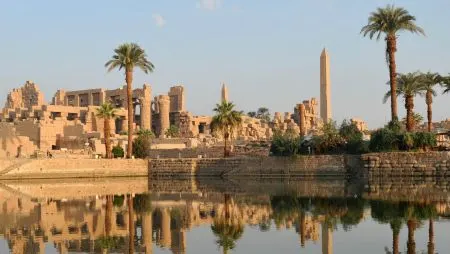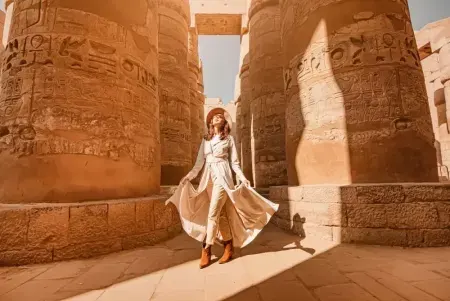The Colossi of Memon, also known as the Colossi of Memnon, are undoubtedly one of the most awe-inspiring and enigmatic ancient structures in Egypt. Located on the western bank of the Nile River near Luxor, these colossal statues have stood the test of time, captivating visitors with their grandeur and mystery. Standing at an impressive height of approximately 18 meters, these imposing statues depict Pharaoh Amenhotep III, who reigned during the 14th century BCE. As you approach these majestic figures, you can't help but be overwhelmed by the sheer scale and artistic finesse of the Colossi of Memon.

Introduction to the Colossi of Memon
The Colossi of Memnon, also known as the Colossi of Memnon, are undoubtedly one of the most awe-inspiring and enigmatic ancient structures in Egypt. Located on the western bank of the Nile River near Luxor, these colossal statues have stood the test of time, captivating visitors with their grandeur and mystery. Standing at an impressive height of approximately 18 meters, these imposing statues depict Pharaoh Amenhotep III, who reigned during the 14th century BCE. As you approach these majestic figures, you can't help but be overwhelmed by the sheer scale and artistic finesse of the Colossi of Memnon.
Historical Significance of the Colossi of Memon
The Colossi of Memon hold immense historical significance, representing the power and influence of Pharaoh Amenhotep III during the New Kingdom period of ancient Egypt. These statues were originally part of a grand mortuary temple dedicated to the pharaoh and were intended to guard his tomb. The temple complex was an architectural marvel, featuring numerous sanctuaries, halls, and courtyards. Unfortunately, most of the temple has been lost to the ravages of time and natural disasters, leaving behind only the two colossal statues that have become synonymous with the Colossi of Memnon.
The Construction and Design of the Colossi of Memon
The construction of the Colossi of Memon is a testament to the engineering prowess of the ancient Egyptians. Carved from massive blocks of quartzite sandstone, each statue weighs an estimated 720 tons. The precision and craftsmanship involved in sculpting these statues is truly remarkable, with intricate details adorning their faces and bodies. The statues were carved in a seated position, with their hands resting on their knees and their feet flat on the ground. Originally, the statues were painted and adorned with various symbols and hieroglyphs, but only traces of the original colors and decorations remain today.
The Symbolism Behind the Colossi of Memon
The Colossi of Memon are not only remarkable for their size and craftsmanship, but they also carry profound symbolism. The seated position of the statues symbolizes stability and power, reflecting the pharaoh's authority and eternal presence. The statues also serve as a reminder of the pharaoh's divine status, with inscriptions praising Amenhotep III's divine lineage and his connection to the gods.
Furthermore, the statues were strategically positioned to align with the rising sun, creating an awe-inspiring spectacle during sunrise. This alignment symbolized the pharaoh's connection to the sun god, Amun-Ra, and his role as a mediator between the gods and the mortal realm.

The Mystery Surrounding the Colossi of Memon
Despite extensive research and excavation, the Colossi of Memon continue to shroud many mysteries. One of the most intriguing aspects is the phenomenon known as the "vocalization of the statues." In ancient times, visitors reported hearing a melodic sound emanating from the statues during sunrise. This phenomenon was believed to be the voice of the pharaoh, communicating with the gods. While this phenomenon ceased after an earthquake in 27 BCE, the mystery surrounding its origin and significance persists. Scholars and archaeologists have proposed various theories, including the vibration of the statues caused by the wind and temperature fluctuations.
Visiting the Colossi of Memon - Practical Information and Tips
If you're planning a visit to the Colossi of Memon, here are some practical tips to make your experience unforgettable. The statues are located in the city of Luxor, which can be reached by air, train, or boat from Cairo. Once in Luxor, you can hire a local guide or join a guided tour that will provide you with fascinating insights into the history and significance of the Colossi of Memon. It is advisable to visit early in the morning to witness the breathtaking sunrise and avoid the crowds. Remember to wear comfortable shoes, as there is some walking involved, and bring plenty of water to stay hydrated in the desert heat. Don't forget your camera to capture the awe-inspiring beauty of these ancient marvels.
Other Ancient Marvels in Egypt
While the Colossi of Memon are undoubtedly a highlight of any trip to Egypt, the country is brimming with other ancient marvels waiting to be explored. Luxor itself is home to the Karnak Temple Complex, the Valley of the Kings, and the Temple of Hatshepsut, all offering a glimpse into the grandeur of ancient Egyptian civilization. A visit to Cairo is a must to marvel at the iconic Pyramids of Giza and the Sphinx. Further south, the temples of Abu Simbel stand as a testament to Ramses II's might. Exploring these ancient wonders will transport you back in time and leave you in awe of the architectural and artistic achievements of the ancient Egyptians.

Preservation Efforts for the Colossi of Memnon
The preservation of the Colossi of Memnon is of utmost importance to ensure their survival for future generations. Over the years, these ancient statues have faced numerous challenges, including natural disasters, erosion, and the effects of tourism. To protect and conserve the statues, various initiatives have been undertaken, including the installation of protective shelters, restoration work, and the implementation of sustainable tourism practices. These efforts aim to strike a balance between allowing visitors to experience the magnificence of the Colossi of Memon while ensuring their long-term preservation.
The Colossi of Memnon in Popular Culture
The Colossi of Memon have left an indelible mark on popular culture, inspiring numerous artistic and literary works. From ancient Egyptian mythology to modern-day novels and movies, these colossal statues have captured the imagination of people throughout history. One notable mention is in the famous poem "Ozymandias" by Percy Bysshe Shelley, where the poet reflects upon the transience of power and empires. The Colossi of Memon have also made appearances in movies, such as "The Mummy Returns," further cementing their place in popular culture and fueling the intrigue and fascination surrounding these ancient wonders.
Conclusion: The Enduring Legacy of the Colossi of Memon
As you conclude your journey into the majestic secrets of the Colossi of Memon, you can't help but be in awe of the ancient marvels that have withstood the test of time. These colossal statues stand as a testament to the advanced engineering skills, artistic brilliance, and spiritual beliefs of the ancient Egyptians. Their historical significance, intricate design, and profound symbolism continue to captivate visitors from around the world. With ongoing preservation efforts and the enduring fascination with these ancient wonders, the Colossi of Memon will continue to inspire and awe for generations to come. So, don't miss the opportunity to uncover the majestic secrets of the Colossi of Memon and embark on a journey into the ancient marvels of Egypt!
Book your trip to Egypt now and experience the awe-inspiring Colossi of Memon firsthand!
.jpg)











.jpg)



